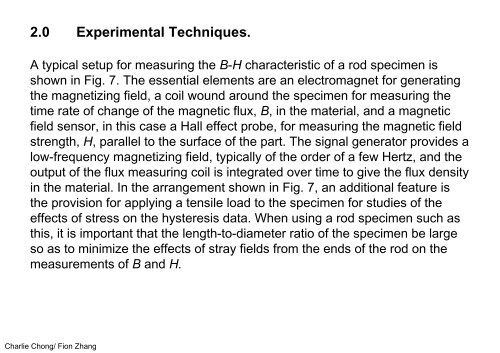Electromagnetic testing emt-mft chapter 9b
Electromagnetic testing emt-mft chapter 9b
Electromagnetic testing emt-mft chapter 9b
You also want an ePaper? Increase the reach of your titles
YUMPU automatically turns print PDFs into web optimized ePapers that Google loves.
2.0 Experimental Techniques.<br />
A typical setup for measuring the B-H characteristic of a rod specimen is<br />
shown in Fig. 7. The essential elements are an electromagnet for generating<br />
the magnetizing field, a coil wound around the specimen for measuring the<br />
time rate of change of the magnetic flux, B, in the material, and a magnetic<br />
field sensor, in this case a Hall effect probe, for measuring the magnetic field<br />
strength, H, parallel to the surface of the part. The signal generator provides a<br />
low-frequency magnetizing field, typically of the order of a few Hertz, and the<br />
output of the flux measuring coil is integrated over time to give the flux density<br />
in the material. In the arrangement shown in Fig. 7, an additional feature is<br />
the provision for applying a tensile load to the specimen for studies of the<br />
effects of stress on the hysteresis data. When using a rod specimen such as<br />
this, it is important that the length-to-diameter ratio of the specimen be large<br />
so as to minimize the effects of stray fields from the ends of the rod on the<br />
measurements of B and H.<br />
Charlie Chong/ Fion Zhang


















